Biography
Interests
Salihu Abdullahi Abubakar1, Abdulrahman Bello2*, Binta Muhammed Manga1, Maryam Bello Ali1, Abdullahi Muazu1 & Dalha Magaji1
1Department of Agricultural Technology, Umaru Ali Shinkafi Polytechnic, Sokoto State, Nigeria
2Department of Veterinary Anatomy, Usmanu Danfodiyo University, Sokoto, Nigeria
*Correspondence to: Dr. Abdulrahman Bello, Department of Veterinary Anatomy, Usmanu Danfodiyo University, Sokoto, Nigeria.
Copyright © 2020 Dr. Abdulrahman Bello, et al. This is an open access article distributed under the Creative Commons Attribution License, which permits unrestricted use, distribution, and reproduction in any medium, provided the original work is properly cited.
Abstract
The study examined the level of participation of women in cowpea production in Wammako Local Government Area of Sokoto State. The specific objectives were to describe the socio-economic characteristics of women cowpea farmers in the study area, determine the level of income of the women in cowpea production, determine the factors influencing the participation of women in cowpea production and identify the constraints to cowpea production by the women. The study was carried out in Wammako Local Government Area of Sokoto State. Purposive and random sampling techniques were used to select fifty (50) respondents across five villages in three districts of the Local Government Area. Descriptive statistics and regression analysis were the analytical tools used to analyze the data collected. Results of the study showed that the women cowpea farmers were in their later stages of 41-50 years. Majority of them were married (62%), with household size of about 4-9 people and most of them (72%) have attempted one form of education or the other however, are small scale farmers with majority (68%) having farm sizes of 0.1-2.0 hectares. Their primary occupation is trading and farming. Their level of income was found to be low to moderate. Farm size and distance to nearest good road (significant at 1% and 5% level respectively) were the factors found to influence women participation in cowpea production. The women cowpea farmers were constrained by pest and diseases, high cost of pesticides and fertilizer, inadequate finance, high cost of labour and poor storage facilities. The study therefore, recommends that government should formulate policies to encourage women farmers, government should also provide incentives specifically to the women farmers like ready market and fixed prices for their outputs, improved cowpea varieties and other inputs should be made readily available and accessible to the women farmers at affordable prices, on time and in adequate quantities, extension service should also be intensified to enhance the women’s knowledge on the utilization of improved farming technologies.
Introduction
Cowpea (Vigna unguiculata) is one of the most important staple food crops in sub-Saharan Africa, especially in Nigeria. Cowpea remains one of the cheapest sources of protein in the diet of many Nigerians with protein content of 25%, in addition to its several mineral and vitamins contents [1]. Almost all parts of cowpea are useful for human consumption and as livestock feed making it one of the most important economic crops in the tropics. The crop tolerates drought. It is adapted to the tropics with temperatures between 28ºC and 30ºC and rainfall between 500 and 1200mm per annum. The crop performs well in a wide variety of soils but performs better on well drained sandy loam to clay loamy soils with pH between six and seven. Similarly, the bacteria in the root nodules contribute to soil fertility through fixation of nitrogen in the soil and production of organic matter. As such, cowpea is broadly cultivated around the world [2]. Nigeria, with an estimated annual production of 2.17 million tons, is the highest producer of cowpea in the world [3]. The northern region of Nigeria produces about 1.7 million tons from about 4 million hectares, which represents over 60% of total national production [3].
Despite the increase in production of cowpea in Nigeria over the years as a result of increase in cultivation, the overall productivity is still very low [2]. The problem of this low productivity has been found to result from the use of local varieties of the crop, poor management practices, lack of sufficient inputs, inefficient extension services and lack of or inadequate use of modern technologies [2,4]. Hence, there is the need to engage women in all production processes as well as to introduce improved technologies.
Women’s contribution to food security in developing countries like Nigeria is well known. Rural women are the mainstay of small-scale agriculture, the farm labour force and day-to-day family subsistence [5]. About 60-80 percent of food in most developing countries is believed to be cultivated by women; as such they are responsible for half of the world’s food production [5]. However, most of women production in developing counties like Nigeria is at subsistence level. This implies that most of what the women produce at most times is being consumed by their household with very little or no produce left for sale. Food insecurity and poverty are serious issues ravaging the female population and in comparison to men, women have a higher incidence and severity of poverty [5,6].
Women performs majority of the farming activities in all phases of agricultural production which include land clearing, land tilling, and planting, weeding, fertilizer/manure application to harvesting, food processing, threshing, winnowing, milling, transportation and marketing as well as the management of livestock [7]. Women in Nigeria are therefore saddled with most tasks in agricultural production that should otherwise be done by men but the benefits gained by them are not measurable to the work they performed. Rural women perform the home chores in addition to the number of hours they spent on the farm. Women are engage in family labour in agriculture as well as wage labour and in other income-earning activities; and generate a substantial proportion and sometimes even the entire basic daily food for the family [8].
Agriculture as the main source of food for the people and as a means of livelihood for the most vulnerable citizens in developing countries plays a major role in the development of such countries. As such, raising agricultural productivity is an important policy goal for governments and development agencies and this is central to growth, income distribution, improved food security and poverty alleviation among farmers, and the most among them are the rural women who play vital roles in agricultural production and they are crucial to the overall success of the efforts directed at agricultural development in rural areas. Women farmers mostly grow cowpea to provide food security both to humans and the livestock as well as to serve as an important source of income for them [2]. Despite being the major labour force in small farms and perform the most of the farming activities, women are hardly appreciated and have limited access to production resources. They hardly have access to loans, grants and credit facilities. They are hardly reached with improved seeds, fertilizers and other inputs. Men still own land, control women’s labour, and make agricultural decisions, extension services are not extended to them, and they are faced with domestic work. It is in view of the above problems that this study seeks to answer the following research questions:
i. What are the socioeconomic characteristics of women farmers in the study area?
ii. What is the level of income of women in cowpea production in the study area?
iii. What are the factors influencing the participation of women in cowpea production?
iv. What are the constraints to cowpea production by women in the study area?
The objective of this study is to examine the level of participation of women farmers in cowpea production in Wammako Local Government Area of Sokoto State. The specific objectives are to: describe the socioeconomic characteristics of the women in the study area, to determine the level of income of the women in cowpea production, to determine the factors influencing the participation of women in cowpea production and to identify constraints to cowpea production by the women in the study area.
The study will focus only on women farmers that engage in the production of cowpea. The target of the study will be to draw detail information on the level of the women in cowpea production as well as how their socio-economic characteristics affect their level of participation and the constraints to their production. The study will be carried out in Wamakko Local Government Area of Sokoto State, and can be generalized to other areas with similar agro-ecological characteristics. The data collected will be limited mainly to the 2019 season.
Materials and Method
Wamakko local government area of Sokoto State is located at latitude 13°2’16’’N and longitude 5°5’37’’E
(Nipost, 2010). It is about 226 meters above the sea level and covers an area of 697 square kilometers with a
population of 179,619 [9]. Wamakko shares boundaries with Tangaza and kware Local Government Areas
to the East, Binji local government to the North, Sokoto North, Sokoto South and Dange Shuni Local
Government Areas to the South and Bodinga and Yabo local government to the West. The local government
is mainly populated by Hausa people. It also comprises of four major villages; Kammata, Gwamatse,
Kaurankimaba and Kokanicidawa. Ambient temperature ranges from 14°C during harmattan period of
November to January to 38°C during the hot season of March to May (SERC, 1992). The vegetation of the
study area is characterized by open grassland interspersed with boa boa, acacia and locust bean trees. The
topography is flat, though there are isolated hills and mountain ranges scattered all over the area. The major
occupation of the inhabitants are farming and rearing of animals.
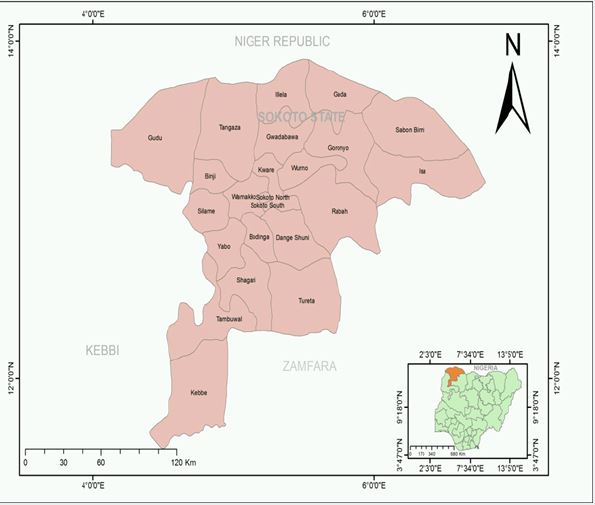
Purposive sampling method was used to select the cowpea farming communities in the study area. Simple
random sampling technique was then employed in selecting ten women farmers from 5 villages that engage
in cowpea production to give a total of 50 farmers that was used for the study. The villages are Kammata,
Fanari (Wammako district) Gumbi, Barkeji (Gumbi district), and Dundaye (Dundaye district).
The data required for this study was collected through the use of a well-structured questionnaire. Information
was collected on socioeconomic characteristics of women farmers, level of income of women in cowpea
production, and constraints to cowpea production by women farmers.
The data was analyzed using descriptive and inferential statistics. Descriptive statistics such as frequency,
percentage and mean score was used to satisfy objectives i, ii and iv, while objective iii was analyzed using
linear regression model. The explicit form of the function is presented as follows:
Yi= a + B1Xi + B2X2 + B3X3 + B4X4 +B5X5+… + BnXn+ U
Y= Participation of women in cowpea production
X1= Household head
X2= farm size
X3= Farm ownership
X4= Membership of Association
X5= Number of extension visit
X6 = Access to credit
X7 = Farm distance to nearest good road
X8 = Village distance to nearest market
X9 = Village distance to nearest good road
B= Coefficient
U= Error term
a= Constant
Results and Discussion
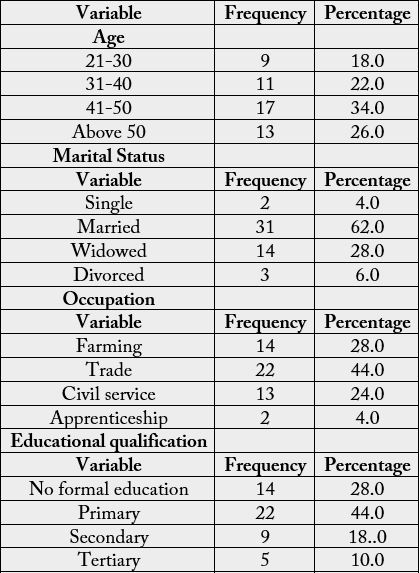

Source: Field Survey, 2019
Table 4.2 below presents the perceived level of income of women engaged in cowpea production. The results
of the finding shows that 50% of the respondents indicates that their level of income was low, whereas 48%
claimed that their level of income was moderate with the remaining 2% indicating a high level of income.
This suggests that 98% of the respondents were low to moderate income earners in the study area. The
findings corroborates with that of Akpabio (2005) [10], Ekong (2003) [11] and Ayoola (1999) [12] who
reported that women farmers has low level of income due to lack of production inputs.
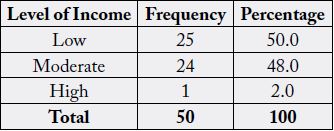
Source: Field Survey, 2019
Table 4.3 below present the regression analysis of the factors influencing cowpea production by women
farmers. The result indicated a coefficient of multiple determinations (R2) of 0.76.This means that 76%
variation in the dependent variable (cowpea production) is explained by variation in the explanatory variables
included in the model. The result further revealed that farm size and distance to nearest good road were
significant at 1%. The positive significance of farm size indicates that the more the farm size the higher the
level of participation of women in cowpea production. The negative coefficient of distance to the nearest
good road implies that the shorter the distance, the higher the level of participation of women in cowpea
production which will results to a higher output
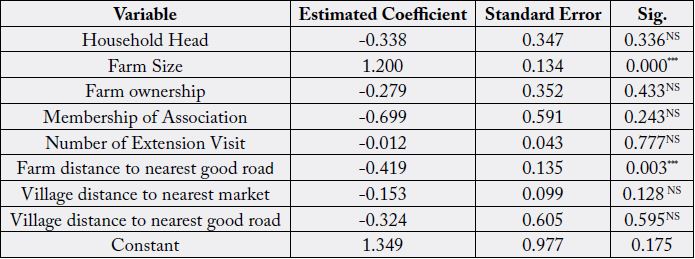
Analysis, 2019
Significant at ***=1% level of significance
NS = Not Significant
R2 = 0.76
Table 4.4 below presents the constraints affecting women participation in cowpea production in Wammako
Local Government Area of Sokoto State. The results of the finding shows that the major constraints affecting
the women farmers were prevalence of pest and diseases (92.0%), followed by high cost of pesticides and
fertilizer (90.0%), Inadequate finance (86.0%), high cost of labour (76.0%), high cost of farm inputs (64.0%)
inadequate land and poor storage facilities (60.0%). Other constraints indicated by the farmers include
shortage of farm inputs, low government participation, poor marketing system and pricing and low level of
income.
Oladebo (2003) [13] and Spore (2003) [14] attributed the low women participation in cowpea production to lack of initial agricultural production capital, which acts as a barrier to women cowpea farmers and also limits their means of hired labour or affording available technology [15-62].
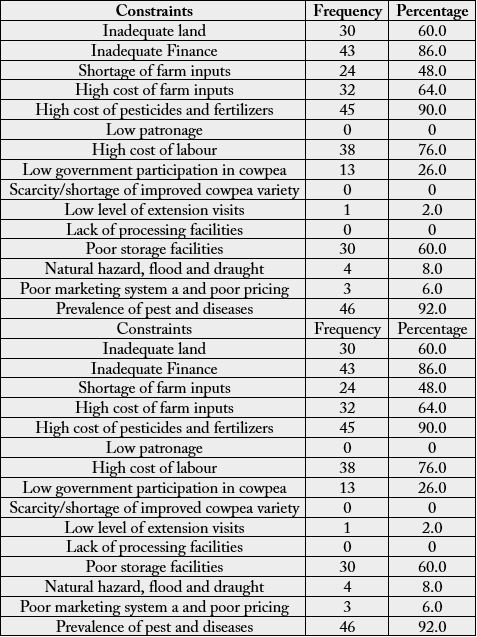
Field Survey, 2019
*Multple Responses observed
Conclusion and Recommendations
Based on the findings, the study therefore conclude that, farming and trading were the major economic
activities of the women farmers in the study area and their level of income is low-moderate and the major
factors that influence their participation in cowpea production were farm size and farm distance to the nearest
good road. This indicates that with adequate farm land and production inputs, they have the potential to
increase their present level of output. The participation of women in cowpea production in the study area is
associated with many constraints which includes high incidence of pests and diseases, high cost of pesticides
and fertilizer, inadequate finance, high cost of labour and poor storage facilities.
Based on the findings of this study, it was recommended that:
1. The government should formulate policies to encourage women farmers in the study area to adopt and
sustain the use of improved varieties of cowpea which will lead to higher yields and as result lead to higher
incomes.
2. The government should provide incentives specifically to the women farmers like ready market and fixed
prices for their outputs. Adequate market infrastructure and facilities should be provided to the women so
that they can easily sell their increased cowpea yields.
3. Improved cowpea varieties and other inputs should be made readily available and accessible to the women
farmers at affordable prices, on time and in adequate quantities.
4. Pests and diseases were major problems of women cowpea farmers as such women farmers in the study
area should be given adequate enlightenment on how to control them. The IITA should also improve the
cowpea varieties to increase their resistance to pests and diseases.
5. Extension service should be intensified to enhance the women’s knowledge
6. Pesticides and fertilizers should be subsidized to make them affordable by the farmers.
7. Land policies that deprived women access to land should be amended so that women can own farmlands
as that will influences their participation in farming activities and cowpea production.
Bibliography

Hi!
We're here to answer your questions!
Send us a message via Whatsapp, and we'll reply the moment we're available!